Monday, 12 December 2016
Monday, 21 November 2016
WHAT ARE THE MONERA, FUNGI AND PROTISTA KINGDOMS LIKE?
What are the characteristics of fungi?
Mushrooms, mould and yeast are all fungi. They have several characteristics in common.
Fungi bodies: Most fungi are multicellular organisms, but some are unicellular, like yeast and mould. Many multicellular fungi consist of a cap, a stem and a networkof hyphae, long tubular structures.
Reproduction: Fungi produce spores that are carried by the wind.
Nutrition: Fungi produce a substance which breaks down plant and animal matter. This enables the fungus to absorb the nutrients from the decaying matter.
What are the characteristics of monerans?
Monerans are microscopic, but not all share the same characteristics.
Moneran shapes: Monerans are simple unicellular organisms; they don´t have bodies. The shape of the cell varies according to the type of organism.
Extremities: Some monerans have a tail that helps them to move around. Others don't move, they stay in one place.
Nutrition: Some monerans produce a substance that breaks down plant or animal matter: they are heterotrophs. This helps them to absorb nutrients. Other monerans make their own food, they are autotrophs.
Reproduction: Most monerans reproduce by dividing. That is, one cell becomes two separate cells.
What is the Protista kingdom like?
Algae and protozoa belong to this Kingdom. There is a wide variety of protists. Each type has specific characteristics.
Protists shapes: Protists can be unicellular or multicellular.
Reproduction: Protists reproduce in two ways. Some produce spores; algae cells divide into two.
Nutrition: Some algae contain chlorophyll and carry out photosynthesis to produce food. They are autotrophs. Others are heterotrophs.
Movement: Some, such as protozoa, don't move. Others move in different ways. Amoebas, for example, move with pseudopods, or false feet, but paramecium move using cilia.
Mushrooms, mould and yeast are all fungi. They have several characteristics in common.
Fungi bodies: Most fungi are multicellular organisms, but some are unicellular, like yeast and mould. Many multicellular fungi consist of a cap, a stem and a networkof hyphae, long tubular structures.
Reproduction: Fungi produce spores that are carried by the wind.
Nutrition: Fungi produce a substance which breaks down plant and animal matter. This enables the fungus to absorb the nutrients from the decaying matter.
 |
| Mushrooms, By JJ Harrison (jjharrison89@facebook.com) (Own work) [CC BY-SA 3.0 (http://creativecommons.org/licenses/by-sa/3.0)], via Wikimedia Commons |
Monerans are microscopic, but not all share the same characteristics.
Moneran shapes: Monerans are simple unicellular organisms; they don´t have bodies. The shape of the cell varies according to the type of organism.
Extremities: Some monerans have a tail that helps them to move around. Others don't move, they stay in one place.
Nutrition: Some monerans produce a substance that breaks down plant or animal matter: they are heterotrophs. This helps them to absorb nutrients. Other monerans make their own food, they are autotrophs.
Reproduction: Most monerans reproduce by dividing. That is, one cell becomes two separate cells.
 |
| By Credit: Rocky Mountain Laboratories, NIAID, NIH [Public domain], via Wikimedia Commons |
What is the Protista kingdom like?
Algae and protozoa belong to this Kingdom. There is a wide variety of protists. Each type has specific characteristics.
Protists shapes: Protists can be unicellular or multicellular.
Reproduction: Protists reproduce in two ways. Some produce spores; algae cells divide into two.
Nutrition: Some algae contain chlorophyll and carry out photosynthesis to produce food. They are autotrophs. Others are heterotrophs.
Movement: Some, such as protozoa, don't move. Others move in different ways. Amoebas, for example, move with pseudopods, or false feet, but paramecium move using cilia.
 |
| By CDC/ Dr. Stan Erlandsen [Public domain], via Wikimedia Commons |
Tuesday, 15 November 2016
HOW CAN WE CLASSIFY PLANTS?
Plants form one of the five kingdoms of living things. As members of the same kingdom, all plants have some characteristics in common.
We can classify plants into groups depending on their characteristics:
SEED PLANTS: seed plants reproduce by creating seeds. There are two main types of seed plant:
We can classify plants into groups depending on their characteristics:
SEED PLANTS: seed plants reproduce by creating seeds. There are two main types of seed plant:
- Angiosperms (or flowering plants): angiosperms grow flowers. Fruit grows from the flowers and the seeds grow inside the fruit.
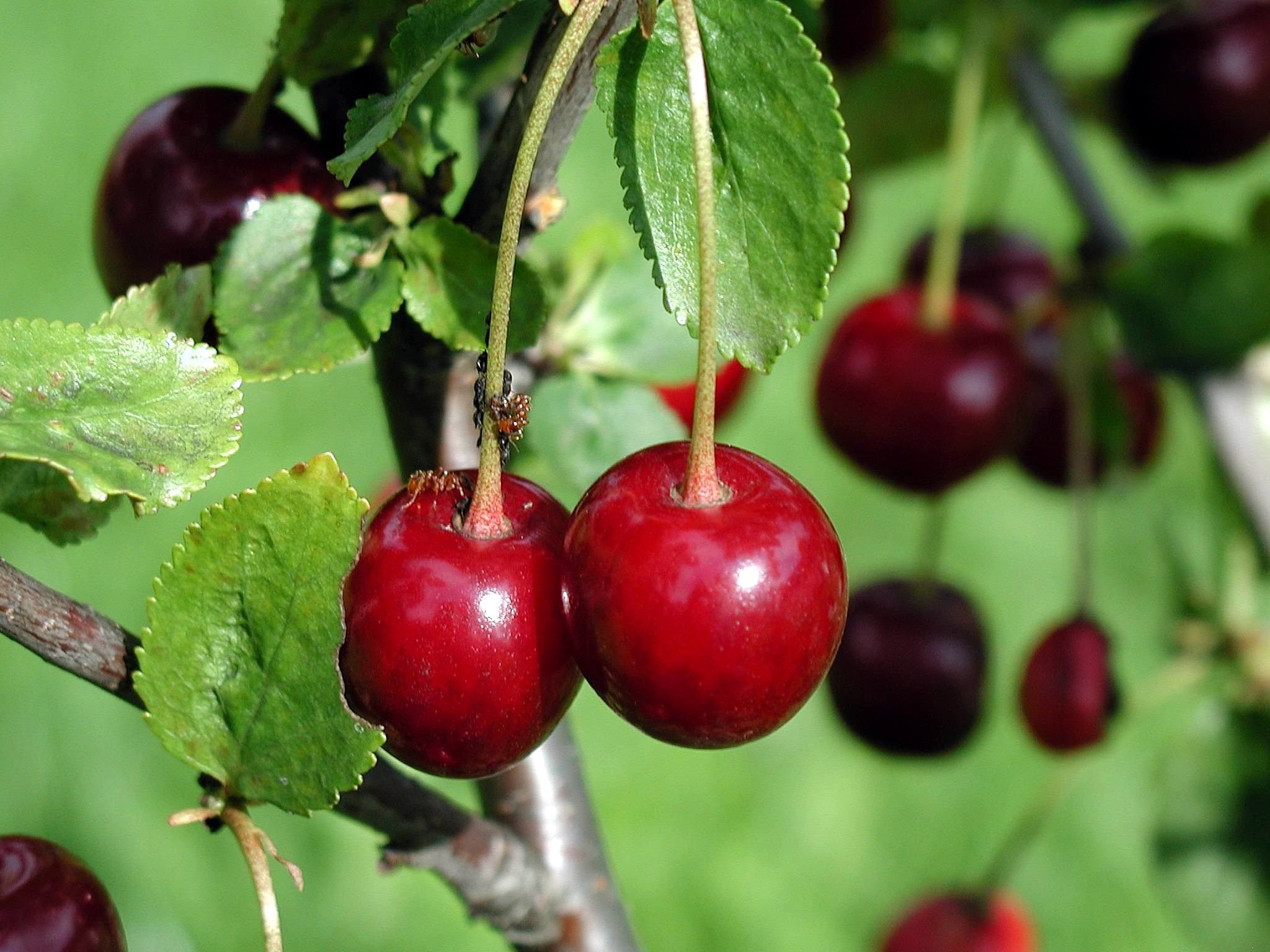
By Paolo Neo [Public domain], via Wikimedia Commons 
By A. Felber (fotografed by myself) [GFDL (http://www.gnu.org/copyleft/fdl.html) or CC BY-SA 3.0 (http://creativecommons.org/licenses/by-sa/3.0)], via Wikimedia Commons - Gymnosperms (conifers): gymnosperms produce cones. The seeds grow inside the cones. Some conifer seeds are called nuts.

Kevin Hale [CC BY-SA 2.0 (http://creativecommons.org/licenses/by-sa/2.0)], via Wikimedia Commons .jpg)
By brewbooks from near Seattle, USA (Bunya Pine cone Showing Bunya nuts) [CC BY-SA 2.0 (http://creativecommons.org/licenses/by-sa/2.0)], via Wikimedia Commons
NON-SEED PLANTS: some plants don´t have seeds. They produce special cells called spores. When spores fall to the ground, they grow into new plants:
- Ferns: ferns have special leaves called fronds. ferns are anchored to the ground by their roots. The roots also absorb water and nutrients from the soil.
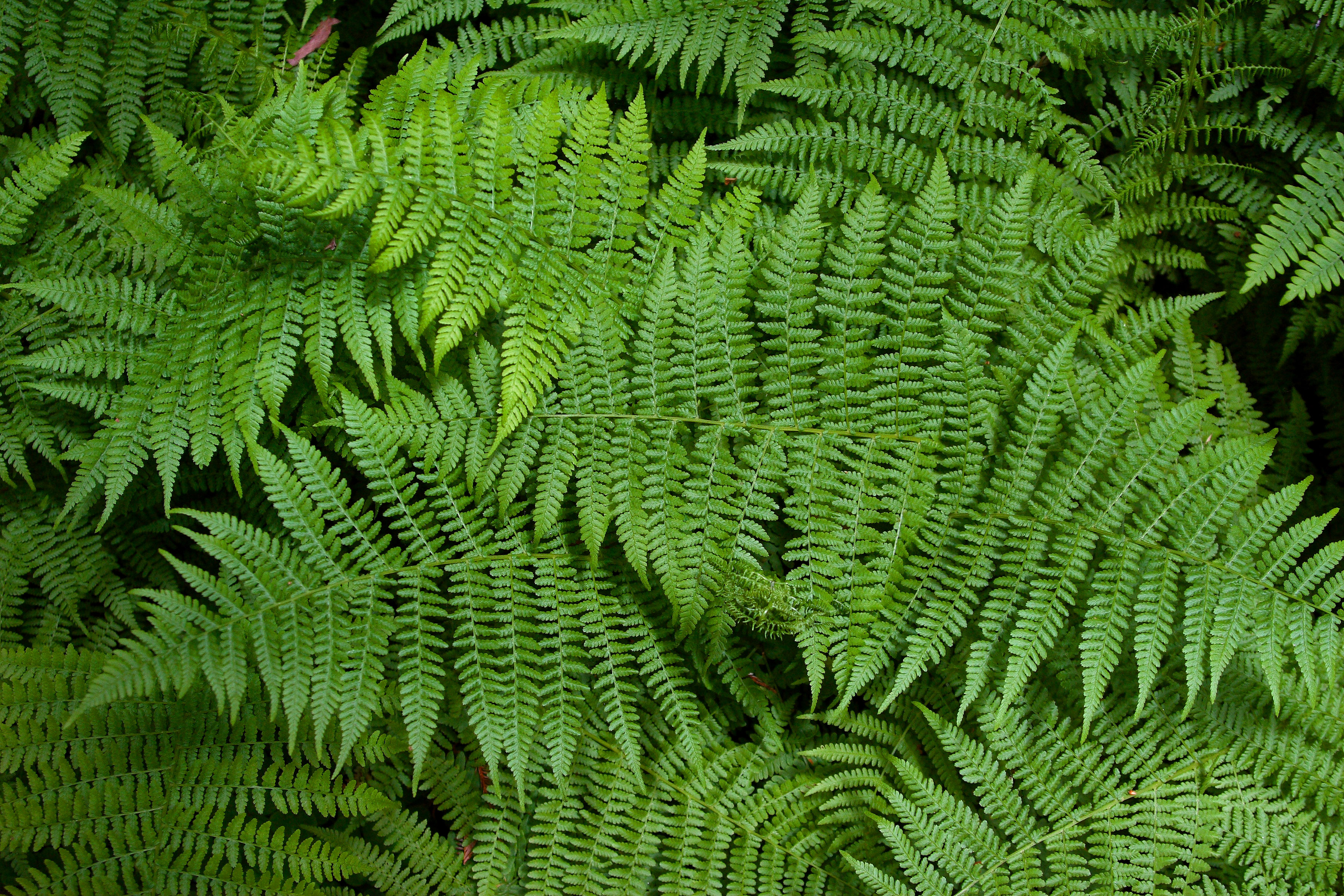
By Sanjay ach (Own work) [GFDL (http://www.gnu.org/copyleft/fdl.html) or CC-BY-SA-3.0 (http://creativecommons.org/licenses/by-sa/3.0/)], via Wikimedia Commons - Mosses: mosses produce capsules. Mosses don't have roots. They are anchored to the ground by rhizoids. Mosses absorb water and nutrients through the rhizoids, stem and leaves.
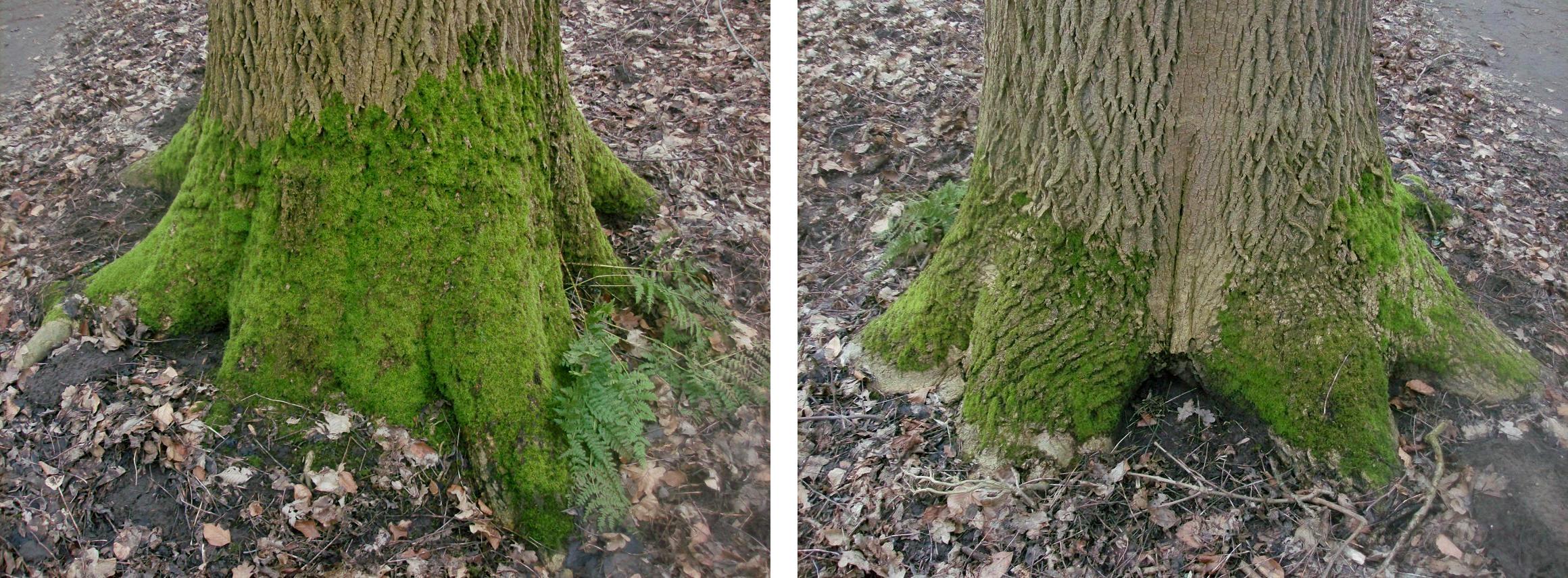
By V. van Zeijst [CC BY 3.0 (http://creativecommons.org/licenses/by/3.0)], via Wikimedia Commons
Monday, 14 November 2016
HOW DO WE CLASSIFY INVERTEBRATE ANIMALS?
Animals that don´t have a spinal cord are called invertebrates. Invertebrate animals are classified into six groups: arthropods, molluscs, porifera, coelenterates, echinoderms and annelids.
Molluscs. These invertebrates have soft bodies, and most also have a hard shell. They absorb oxygen through gills, and reproduce by laying eggs.
Coelenterates. These animals have a soft body. Some have long tentacles. They absorb oxygen through their skin. They reproduce by growing a bud, or small body part. Eventually the bud breaks off and grows into a new organism.
Porifera (or sponges). These invertebrates have a soft body with holes called pores. They absorb oxygen and nutrients through the pores. They reproduce by forming buds.
Echinoderms. These animals have bodies covered with sharp spikes. Some also have arms and tentacles. Some echinoderms have gills, others absorb oxygen through their skin. Echinoderms are oviparous.
Arthropods. These invertebrates have an exoskeleton and jointed legs that bend. Some arthropods have simple lungs. Others absorb oxygen through their gills. Arthropods are oviparous.
Annelids. These animals have a long, soft body that is divided into rings called segments. Some annelids absorb oxygen through their skin, but other have gills. Annelids can reproduce by budding, but some are oviparous.
Shells, exoskeletons and soft bodies with no protective body covering are the three types of body coverings found in invertebrates. Each one is typical of a specific type of invertebrate.
Molluscs. These invertebrates have soft bodies, and most also have a hard shell. They absorb oxygen through gills, and reproduce by laying eggs.
Coelenterates. These animals have a soft body. Some have long tentacles. They absorb oxygen through their skin. They reproduce by growing a bud, or small body part. Eventually the bud breaks off and grows into a new organism.
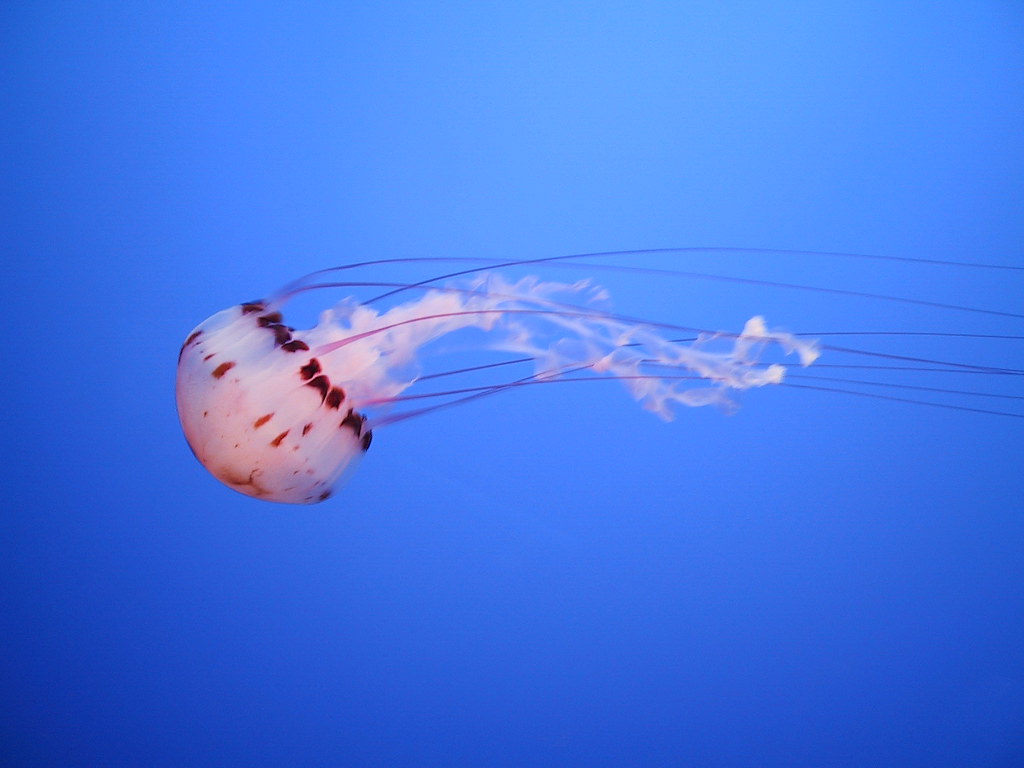 |
| Jellyfish are coelenterates. Photo from flickr by NBPhotostream |
.jpg) |
| By Nhobgood Nick Hobgood (Own work) [CC BY-SA 3.0 (http://creativecommons.org/licenses/by-sa/3.0) or GFDL (http://www.gnu.org/copyleft/fdl.html)], via Wikimedia Commons |
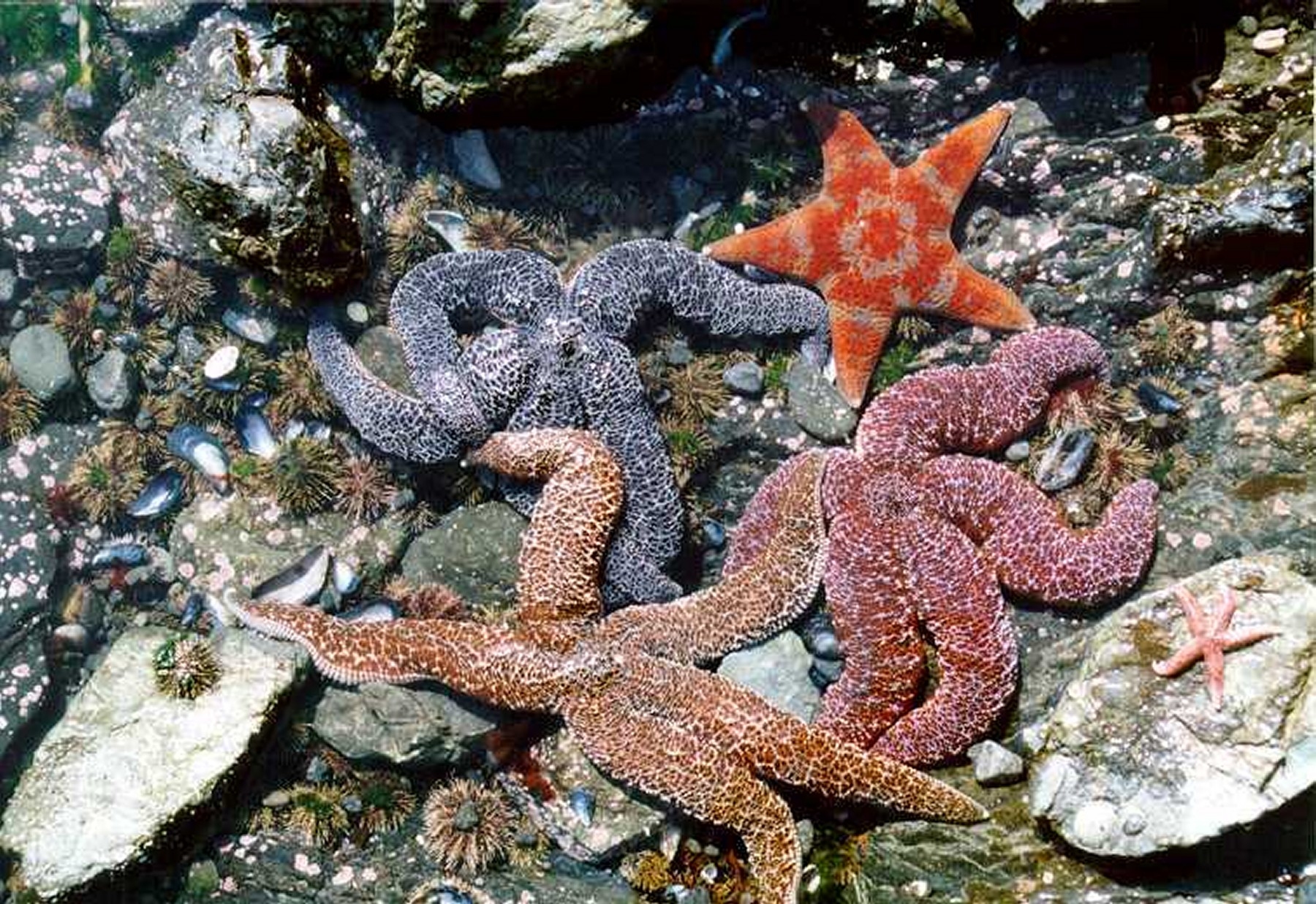 |
| Photo from wikimedia. |
Annelids. These animals have a long, soft body that is divided into rings called segments. Some annelids absorb oxygen through their skin, but other have gills. Annelids can reproduce by budding, but some are oviparous.
Shells, exoskeletons and soft bodies with no protective body covering are the three types of body coverings found in invertebrates. Each one is typical of a specific type of invertebrate.
NÚMEROS COMPUESTOS
Los números compuestos son aquellos que tienen divisores distintos de ellos mismos y la unidad. Los podemos expresar en forma de un producto que no incluye al número 1.
Por ejemplo:
6 = 3 x 2
10 = 5 x 2
16 = 4 x 4
Así 6, 10 y 16 son números complejos.
Por ejemplo:
6 = 3 x 2
10 = 5 x 2
16 = 4 x 4
Así 6, 10 y 16 son números complejos.
Sunday, 13 November 2016
WHAT OTHER GROUPS OF VERTEBRATES ARE THERE?
What are the characteristics of fish?
Respiration. Fish breathe with their gills. The gills absorb the oxygen from the water and pass it into the blood.
Fish bodies. Fish have a long body that is covered with scales.
Extremities. Fish have fins and tails. They use them to swim.
Reproduction. Almost all fish are oviparous. The females produce eggs and lay them in the water.
What are the characteristics of birds?
Respiration. Birds have lungs to breathe air.
Bird bodies. Birds have aerodynamic bodies. Their bones are thin and light, with lots of air spaces inside. These characteristics make it easier for them to fly.
Extremities. Birds have four extremities: two legs and two wings.
Reproduction. Birds are oviparous. Like reptiles, amphibians and fish, birds lay eggs.
What are the characteristics of amphibians?
Amphibian bodies. Amphibians have thin, smooth skin.
Extremities. Amphibians have four legs.
Respiration. When amphibians are young, they breathe in water. When amphibians become adults, they grow lungs, breathe air and live on land.
Reproduction. Amphibians are oviparous.
Respiration. Fish breathe with their gills. The gills absorb the oxygen from the water and pass it into the blood.
Fish bodies. Fish have a long body that is covered with scales.
Extremities. Fish have fins and tails. They use them to swim.
Reproduction. Almost all fish are oviparous. The females produce eggs and lay them in the water.
 |
| Photo by Adam Summers via cultura inquieta. Click on the link and you'll see lots of incredible pictures. |
What are the characteristics of birds?
Respiration. Birds have lungs to breathe air.
Bird bodies. Birds have aerodynamic bodies. Their bones are thin and light, with lots of air spaces inside. These characteristics make it easier for them to fly.
Extremities. Birds have four extremities: two legs and two wings.
Reproduction. Birds are oviparous. Like reptiles, amphibians and fish, birds lay eggs.
Amphibian bodies. Amphibians have thin, smooth skin.
Extremities. Amphibians have four legs.
Respiration. When amphibians are young, they breathe in water. When amphibians become adults, they grow lungs, breathe air and live on land.
Reproduction. Amphibians are oviparous.
Saturday, 12 November 2016
HOW DO WE CLASSIFY VERTEBRATE ANIMALS?
What are the characteristics of mammals?
Respiration: All mammals have lungs to breathe air.
Mammals' bodies: Skin and hair cover mammals' bodies. In some animals, the hair is thick and called fur.
Extremities: Most terrestrial mammals have four legs, but human beings have two legs and two arms. Aquatic mammals have fins fro swimming. Many terrestrial mammals also have a tail.
Reproduction: Almost all mammals are viviparous. This means that female mammals give birth to live young. They produce milk to feed their young.
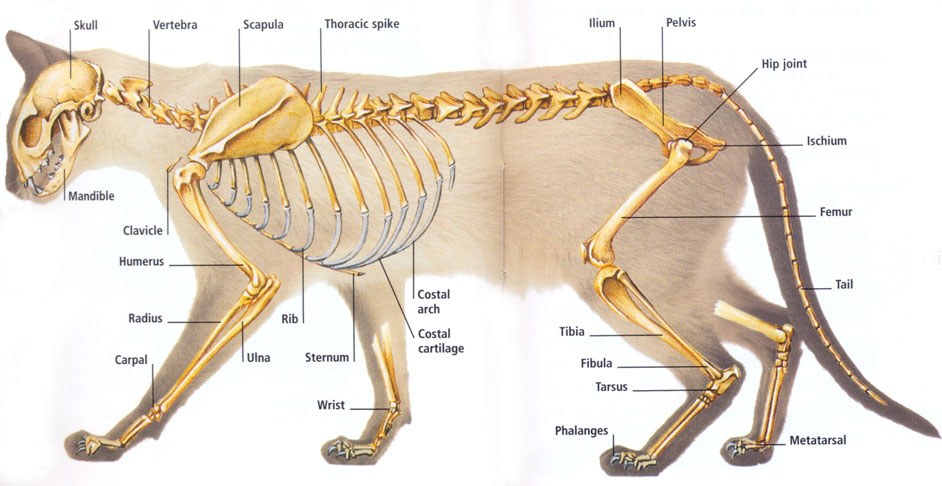 |
| Photo from Fascinating animals from Feline anatomy. |
 |
| Photo from Dolphins by Miss Hilda |
What are the characteristics of reptiles?
Reptile bodies: Reptiles have hard scales to protect their body. Some reptiles have a hard shell.
Reproduction: Reptiles are oviparous animals. Their young are born from eggs. Reptiles lay their eggs on land.
Respiration: Reptiles have lungs to breathe air.
Extremities: Many reptiles have four legs, but snakes are reptiles that don't have legs.
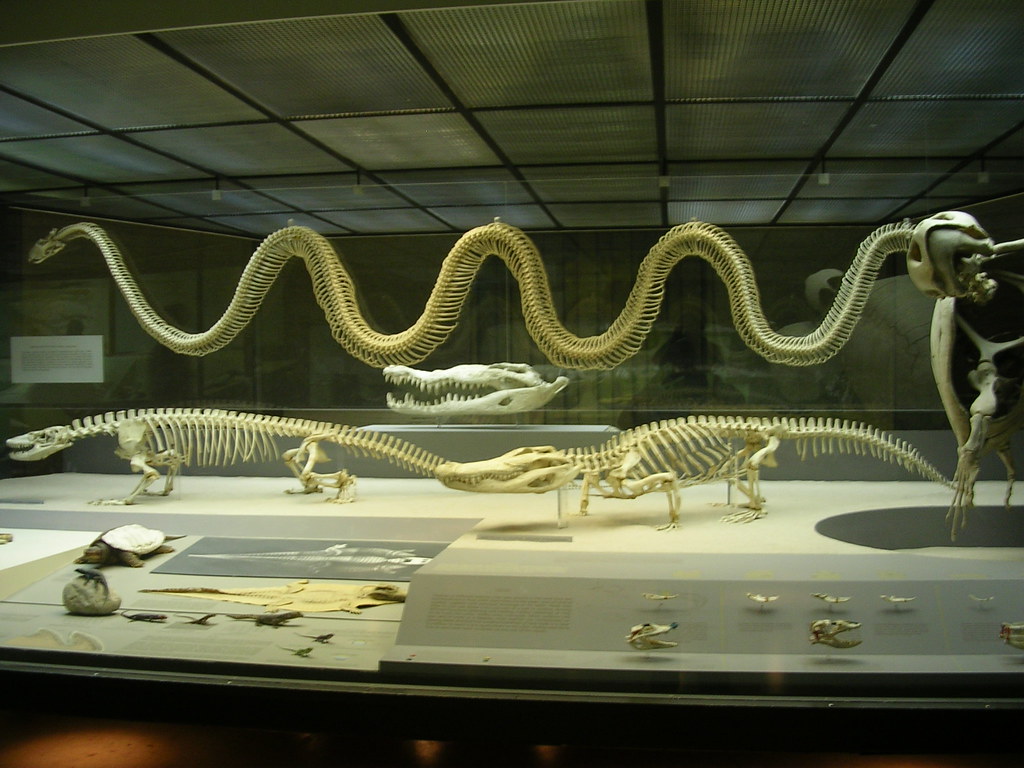 |
| Photo via flickr by pabloskijj. |
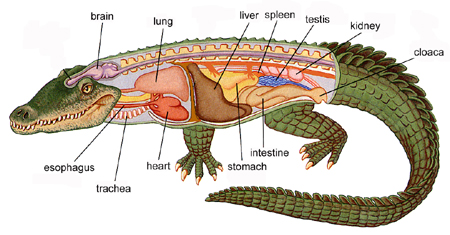 |
| Photo from understanding vertebrates. |
NÚMEROS PRIMOS
Los números primos son aquellos que solo son divisibles por sí mismos y por la unidad (1).
Por lo tanto no se pueden descomponer en un producto de factores más sencillos.
Para averiguar si un número es primo vamos dividiéndolo por 2, por 3, por 5, por 7... Si alguna de las divisiones es exacta, entonces el número no es primo, es compuesto. Si ninguna de las divisiones da exacta, entonces el número es primo.
Vamos a ver dos ejemplos: 15 y 17.
15 : 2 = 7, R=1;
15 : 3 = 5, R=0 => División exacta => 15 no es número primo, 15 = 5 x 3
17 : 2 = 8, R=1 (si no es divisible por 2, no es divisible por ningún número par, ya que todos los pares son múltiplos de 2);
17 : 3 = 5, R=2 (si no es divisible por 3, no es divisible por ningún múltiplo de 3, así que no probaré con ninguno de ellos: 6, 9, 12, 15...);
17 : 4 (no pruebo, ya que 4 es múltiplo de 2 y ya hemos visto que 17 no es divisible por 2);
17 : 5 = 3, R=2 (no es divisible por 5, no lo será tampoco por ningún múltiplo de 5);
17 : 6 (no pruebo, ya sé que 6 es múltiplo de 2 y de 3, y 17 no es divisible ni por 2 ni por 3);
17 : 7 = 2, R=3;
17 : 11 = 1, R=6;
17 : 13 = 1, R=4;
No encuentro ningún divisor de 17 diferente de 17 y de 1, así que 17 es un número primo.
Aquí está la lista de los números primos comprendidos entre los primeros 30, con la demostración: (el 1 es un número que no se considera primo)
En este enlace que te dejo aquí encontrarás un juego que te demuestra si un número es primo o no.
Y en este otro enlace puedes aprender sobre los números primos.
Y pinchando aquí podrás jugar con los números primos. Es un juego de sexto, pero seguro que te resultará fácil.
Por lo tanto no se pueden descomponer en un producto de factores más sencillos.
Para averiguar si un número es primo vamos dividiéndolo por 2, por 3, por 5, por 7... Si alguna de las divisiones es exacta, entonces el número no es primo, es compuesto. Si ninguna de las divisiones da exacta, entonces el número es primo.
Vamos a ver dos ejemplos: 15 y 17.
15 : 2 = 7, R=1;
15 : 3 = 5, R=0 => División exacta => 15 no es número primo, 15 = 5 x 3
17 : 2 = 8, R=1 (si no es divisible por 2, no es divisible por ningún número par, ya que todos los pares son múltiplos de 2);
17 : 3 = 5, R=2 (si no es divisible por 3, no es divisible por ningún múltiplo de 3, así que no probaré con ninguno de ellos: 6, 9, 12, 15...);
17 : 4 (no pruebo, ya que 4 es múltiplo de 2 y ya hemos visto que 17 no es divisible por 2);
17 : 5 = 3, R=2 (no es divisible por 5, no lo será tampoco por ningún múltiplo de 5);
17 : 6 (no pruebo, ya sé que 6 es múltiplo de 2 y de 3, y 17 no es divisible ni por 2 ni por 3);
17 : 7 = 2, R=3;
17 : 11 = 1, R=6;
17 : 13 = 1, R=4;
No encuentro ningún divisor de 17 diferente de 17 y de 1, así que 17 es un número primo.
Aquí está la lista de los números primos comprendidos entre los primeros 30, con la demostración: (el 1 es un número que no se considera primo)
 |
| En rojo tienes los números primos y en negro los que no lo son, los compuestos. En azul los productos que demuestran que los números son compuestos. |
Y en este otro enlace puedes aprender sobre los números primos.
Y pinchando aquí podrás jugar con los números primos. Es un juego de sexto, pero seguro que te resultará fácil.
WHAT SYSTEMS DO LIVING THINGS HAVE?
Animal bodies are made up of several systems. Animals and human beings carry out the basic life process of interaction, nutrition and reproduction with these systems.
Nutrition:
Our digestive system uses the food and water we eat or drink to provide energy for our muscles. The respiratory system absorbs oxygen and the circulatory system transports it to our muscles so we can move and grow.
Interaction:
The sense organs, the nerves and the brain form the nervous system: it detects information. The muscular and skeletal systems enable us to react to that information.
Reproduction:
Our reproductive system enables us to reproduce by having children. To reproduce, male and female cells combine and slowly develop into an embryo, and then a foetus. The foetus grows into a baby in its mother's uterus.
Nutrition:
Our digestive system uses the food and water we eat or drink to provide energy for our muscles. The respiratory system absorbs oxygen and the circulatory system transports it to our muscles so we can move and grow.
Interaction:
The sense organs, the nerves and the brain form the nervous system: it detects information. The muscular and skeletal systems enable us to react to that information.
Reproduction:
Our reproductive system enables us to reproduce by having children. To reproduce, male and female cells combine and slowly develop into an embryo, and then a foetus. The foetus grows into a baby in its mother's uterus.
HOW ARE PLANTS ORGANISED?
Plants have cells, tissues, organs and systems.
Cells:
Plant cells have a rigid cell wall. Photosynthesis takes place in leaf cells. Those cells contain a green liquid called chlorophyll and a liquid called sap that is used to make food for the plant.
Tissue:
Plant tissue is made up of many cells joined together.
Organs:
Organs are made up of tissue. A leaf is an organ.
Systems:
Systems are groups of organs and tissue that work together to carry out a function.
Roots:
The functions of the roots is absorb wter and nutrients from the soil. root cells have root hairs. As a result, the roots can absorb more water and minerals.
Cells:
Plant cells have a rigid cell wall. Photosynthesis takes place in leaf cells. Those cells contain a green liquid called chlorophyll and a liquid called sap that is used to make food for the plant.
Tissue:
Plant tissue is made up of many cells joined together.
Organs:
Organs are made up of tissue. A leaf is an organ.
Systems:
Systems are groups of organs and tissue that work together to carry out a function.
Roots:
The functions of the roots is absorb wter and nutrients from the soil. root cells have root hairs. As a result, the roots can absorb more water and minerals.
HOR ARE ANIMALS ORGANISED?
Cells:
Multicellular organisms have many types of cells. The cells are different shapes according to their function.
Tissue:
Cells join together to form tissue. Each type of tissue has a specific function.
Organs:
Organs are made up of different tissues.
Systems:
Systems are groups of organs that work together to perform a function.
There are many types of cells in multicellular organisms. Each type has a specific function and a unique appearance:
Red blood cells. They are flat and circular. They carry oxygen from the lungs to the muscles and organs.
Nerve cells. They are star-shaped. They transmit nerve impulses from different parts of the body to the brain.
Reproductive cells. They enable us to reproduce. Female reproductive cells are spherical. Male reproductive cells are oval with a long tail.
Friday, 11 November 2016
WHAT ARE LIVING THINGS MADE UP OF?
All living things are made up of cells. Cells are the basic units of life. They are living things. Cells are very small.
Cells carry out the basic life processes of interaction, nutrition and reproduction.
Animal cell.
The nucleus controls everything that happens inside the cell.
The membrane surrounds and protects the cell.
In the cytoplasm, we find special organelles that carry out different life processes.
The cytoplasm is a thick, clear liquid protected by the membrane.
Plant cell.
In the cytoplasm of plant cells,there are special organelles called chloroplasts. They contain a green liquid called chlorophyll.
Plant cells have a rigid cell wall around the membrane. This helps support the plant.
Plant cells have a vacuole, which is like a bag. Food and water are stored in the vacuole. When a plant doesn't have enough water, the plant loses its rigid structure and begins to wilt.
Unicellular and multicellular organisms.
Some living things, such as bacteria or yeast, are made up of only one cell. They're unicellular organisms.
Other living things, such as trees or butterflies, have many cells. They're multicellular organisms.
Cells carry out the basic life processes of interaction, nutrition and reproduction.
Animal cell.
The nucleus controls everything that happens inside the cell.
The membrane surrounds and protects the cell.
In the cytoplasm, we find special organelles that carry out different life processes.
The cytoplasm is a thick, clear liquid protected by the membrane.
Plant cell.
In the cytoplasm of plant cells,there are special organelles called chloroplasts. They contain a green liquid called chlorophyll.
Plant cells have a rigid cell wall around the membrane. This helps support the plant.
Plant cells have a vacuole, which is like a bag. Food and water are stored in the vacuole. When a plant doesn't have enough water, the plant loses its rigid structure and begins to wilt.
Unicellular and multicellular organisms.
Some living things, such as bacteria or yeast, are made up of only one cell. They're unicellular organisms.
Other living things, such as trees or butterflies, have many cells. They're multicellular organisms.
WHAT DO LIVING THINGS DO?
All living things carry out the basic life processes of interaction, nutrition and reproduction.
Interaction:
All living things detect information in their environment. Then they react to this information in different ways.
Nutrition:
All living things take in essential nutrients from their environment. These nutrients give them energy and enable them to grow and develop.
Reproduction:
Living things can create new members of their own species. Different organisms reproduce in a specific way.
Human beings carry out the basic life processes of interaction, nutrition and reproduction:
Interaction. We interact with the world around us. We use our senses to detect information about the world.
Nutrition. We carry out nutrition by drinking water and eating food. The oxygen we take in is also part of the process. Finally, we eliminate waste products.
Reproduction. we reproduce to make new members of our species.
Interaction:
All living things detect information in their environment. Then they react to this information in different ways.
Nutrition:
All living things take in essential nutrients from their environment. These nutrients give them energy and enable them to grow and develop.
Reproduction:
Living things can create new members of their own species. Different organisms reproduce in a specific way.
Human beings carry out the basic life processes of interaction, nutrition and reproduction:
Interaction. We interact with the world around us. We use our senses to detect information about the world.
Nutrition. We carry out nutrition by drinking water and eating food. The oxygen we take in is also part of the process. Finally, we eliminate waste products.
Reproduction. we reproduce to make new members of our species.
Thursday, 10 November 2016
SOCIAL SCIENCE PROJECT UNIT 1
In this Project we're going to create a pyramid Graph.
The first step will be to collect the data.
I gave you a worksheet with the data. but in this worksheet the age groups are 0-4, 5-9, 10-14...
To create our pyramid graph we are using different age groups, so you have to group them this way: 0-9, 10-19, 20-29...
The only thing you have to do is to add up both groups, create a new chart.
In this picture you can see it:
When you have done it, give it to me and I'll give you more instructions.
The first step will be to collect the data.
I gave you a worksheet with the data. but in this worksheet the age groups are 0-4, 5-9, 10-14...
To create our pyramid graph we are using different age groups, so you have to group them this way: 0-9, 10-19, 20-29...
The only thing you have to do is to add up both groups, create a new chart.
In this picture you can see it:
When you have done it, give it to me and I'll give you more instructions.
CRITERIOS DE DIVISIBILIDAD II
Para saber si un número es divisible por 3 lo que tenemos que hacer es sumar sus cifras. Si el resultado es múltiplo de 3, el número es divisible por 3. Si el resultado no es múltiplo de 3, entonces el número no es divisible por tres.
Por ejemplo:
501 => 5 + 0 + 1 = 6 => 6 es múltiplo de 6, por lo tanto 501 es múltiplo de 3.
501 : 3 = 167, R=0
232 => 2 + 3 + 2 = 7 => 7 no es múltiplo de 7, por lo tanto 232 no es múltiplo de 7.
232 : 3 = 77, R=1
Puedes practicar pinchando en este enlace.
Para saber si un número es divisible por 9 tenemos que sumar sus cifras. Si el resultado es múltiplo de 9, el número es divisible por 9. Si el resultado no es múltiplo de 9, entonces el número no es divisible por 9.
Por ejemplo:
711 => 7 + 1 + 1 = 9 => 9 es múltiplo de 9, por lo tanto 711 es múltiplo de 9.
711 : 9 = 79, R=0
527 => 5 + 2 + 7 = 14 => 14 no es múltiplo de 9, por lo tanto 527 no es múltiplo de 9.
527 : 9 = 58, R=5
Puedes practicar pinchando en el siguiente enlace.
Por ejemplo:
501 => 5 + 0 + 1 = 6 => 6 es múltiplo de 6, por lo tanto 501 es múltiplo de 3.
501 : 3 = 167, R=0
232 => 2 + 3 + 2 = 7 => 7 no es múltiplo de 7, por lo tanto 232 no es múltiplo de 7.
232 : 3 = 77, R=1
Puedes practicar pinchando en este enlace.
Para saber si un número es divisible por 9 tenemos que sumar sus cifras. Si el resultado es múltiplo de 9, el número es divisible por 9. Si el resultado no es múltiplo de 9, entonces el número no es divisible por 9.
Por ejemplo:
711 => 7 + 1 + 1 = 9 => 9 es múltiplo de 9, por lo tanto 711 es múltiplo de 9.
711 : 9 = 79, R=0
527 => 5 + 2 + 7 = 14 => 14 no es múltiplo de 9, por lo tanto 527 no es múltiplo de 9.
527 : 9 = 58, R=5
Puedes practicar pinchando en el siguiente enlace.
Tuesday, 8 November 2016
CRITERIOS DE DIVISIBILIDAD
Los criterios de divisibilidad nos permiten saber fácilmente si un número es múltiplo de 2, de 3, de 5 y de otros números sencillos.
Así, al saber si son múltiplos, también sabremos si el 2, el 3, el 5,..., son divisores suyos.
Múltiplos de 2:
Todos lo números que acaban en cifra par (2, 4, 6, 8) o en 0, son múltiplos de 2. De este modo, el dos es divisor de todos los números que acaban en cifra par o en 0.
Múltiplos de 5:
Todos los números que terminan en 5 o en 0 son múltiplos de 5. Así, el 5 es divisor de todos los números que acaban en 5 o en 0.
Múltiplos de 10:
Podemos observar que los números acabados en 0 están en las dos listas, esto quiere decir que los números que acaban en 0 son múltiplos de 2 y de 5.
2 por 5 son 10, así que si son múltiplos de 2 y de 5, son múltiplos de 10 también. Por ello, el 10 es un divisor de los números que acaban en 0.
Pinchando en la imagen podrás practicar jugando: (deberás seleccionar la la divisibilidad por 2 y la divisibilidad por 5, y si te atreves prueba con la divisibilidad por 10).
Así, al saber si son múltiplos, también sabremos si el 2, el 3, el 5,..., son divisores suyos.
Múltiplos de 2:
Todos lo números que acaban en cifra par (2, 4, 6, 8) o en 0, son múltiplos de 2. De este modo, el dos es divisor de todos los números que acaban en cifra par o en 0.
Múltiplos de 5:
Todos los números que terminan en 5 o en 0 son múltiplos de 5. Así, el 5 es divisor de todos los números que acaban en 5 o en 0.
Múltiplos de 10:
Podemos observar que los números acabados en 0 están en las dos listas, esto quiere decir que los números que acaban en 0 son múltiplos de 2 y de 5.
2 por 5 son 10, así que si son múltiplos de 2 y de 5, son múltiplos de 10 también. Por ello, el 10 es un divisor de los números que acaban en 0.
Pinchando en la imagen podrás practicar jugando: (deberás seleccionar la la divisibilidad por 2 y la divisibilidad por 5, y si te atreves prueba con la divisibilidad por 10).
Monday, 7 November 2016
DIVISORES DE UN NÚMERO
Para encontrar los divisores de un número, buscamos todas las divisiones exactas en las que ese número es el dividendo.
Por ejemplo, calculemos los divisores de 6:
6 : 1 = 6, R=0; 6 : 2 = 3, R=0; 6 : 3 = 2, R=0;6 : 4 = 1, R=2; 6 : 5 = 1, R=1; 6 : 6 = 1, R=0.
Así los divisores de 6 son 1, 2, 3, 6.
Aquí tenéis un vídeo que os ayudará a entenderlo:
Y pinchando en este enlace podrás jugar. Y aquí tienes otro enlace en el que puedes practicar múltiplos y divisores.
Por ejemplo, calculemos los divisores de 6:
6 : 1 = 6, R=0; 6 : 2 = 3, R=0; 6 : 3 = 2, R=0;
Así los divisores de 6 son 1, 2, 3, 6.
Aquí tenéis un vídeo que os ayudará a entenderlo:
Y pinchando en este enlace podrás jugar. Y aquí tienes otro enlace en el que puedes practicar múltiplos y divisores.
MÚLTIPLOS DE UN NÚMERO
Los múltiplos de un número se obtienen multiplicando ese número por los números naturales: 1, 2, 3, 4, 5...
Por ejemplo, los múltiplos de 4.
4 x 1 = 4 4 x 2 = 8 4 x 3 = 12 4 x 4 = 16 4 x 5 = 20 4 x 10 = 40 4 x 35 = 140
Los números 4, 8, 12, 16, 20, 40, 140 ... son múltiplos de 4.
Así, si dividimos cualquiera de estos números por 4, la división será exacta, el resto será 0.
Puedes ver este vídeo:
Y ahora practicar jugando (pincha en las imágenes o en las actividades):
Por ejemplo, los múltiplos de 4.
4 x 1 = 4 4 x 2 = 8 4 x 3 = 12 4 x 4 = 16 4 x 5 = 20 4 x 10 = 40 4 x 35 = 140
Los números 4, 8, 12, 16, 20, 40, 140 ... son múltiplos de 4.
Así, si dividimos cualquiera de estos números por 4, la división será exacta, el resto será 0.
Puedes ver este vídeo:
Y ahora practicar jugando (pincha en las imágenes o en las actividades):
Sunday, 6 November 2016
REPASO TEMA 1
Aquí os dejo la ficha de repaso del tema 1 de Matemáticas, y pronto las soluciones, para que podáis comprobar si vuestros resultados son correctos.
Aquí os dejo las soluciones, para que podáis comprobar si los habéis hecho bien, y si habéis fallado, revisad o consultad mañana en clase.
Monday, 31 October 2016
WHAT'S THE POPULATION OF EUROPE LIKE?
Europe's population is about 730 million people. The population of the 28 European countries that make up the European Union (EU) is 507 million people.
The population density of the EU is 114 per km2. Ireland and Greece have low population densities. Germany and the UK have high population densities.
The fertility rate of the EU is 1.6 children per family. Ireland and France have higher fertility rates. Portugal and Germany have lower fertility rates.
The EU's population is 52% female and 48% male.
The average age of people living in the EU is increasing. This can cause problems in the future because there are many retired people and fewer people working.
There are 28 countries in the EU. The EU's population contains many different ethnic groups. There's a lot of inmigration to the EU from non-EU countries. People also migrate from one EU country to another. The nationality with the highest number of people in the EU is German, and Turks are the largest inmigrant group. 7% of the people who live in the EU are inmigrants from non-EU countries.
The population density of the EU is 114 per km2. Ireland and Greece have low population densities. Germany and the UK have high population densities.
The fertility rate of the EU is 1.6 children per family. Ireland and France have higher fertility rates. Portugal and Germany have lower fertility rates.
The EU's population is 52% female and 48% male.
The average age of people living in the EU is increasing. This can cause problems in the future because there are many retired people and fewer people working.
There are 28 countries in the EU. The EU's population contains many different ethnic groups. There's a lot of inmigration to the EU from non-EU countries. People also migrate from one EU country to another. The nationality with the highest number of people in the EU is German, and Turks are the largest inmigrant group. 7% of the people who live in the EU are inmigrants from non-EU countries.
 |
| Europe Population Density Map, from Online Maps by Rand McNally. |
And now, let's play:
WHAT'S THE POPULATION OF SPAIN LIKE?
The population of Spain is about 46.7 million people. Spain has a low population density and it also has a low fertility rate.
Population density:
Spain's population density is 91 per km2.
In some areas such as cities, there are many more people living in each square kilometre.
In rural areas, there are a lot fewer.
There is also a higher population density in coastal areas.
Spain's population density is lower than most other European countries.
Fertility rate:
The fertility rate in Spain is 1.47 children per family. This is also lower than most other European countries.
Spain's population:
Spain's population has increased during the past century. Population growth was especially high from 2000 to 2011. This growth was the result of inmigration to Spain from other countries. In 2012, the population of Spain began to decrease as inmigrants returned home. This was because of high unemployment in Spain.
Population density:
Spain's population density is 91 per km2.
In some areas such as cities, there are many more people living in each square kilometre.
In rural areas, there are a lot fewer.
There is also a higher population density in coastal areas.
Spain's population density is lower than most other European countries.
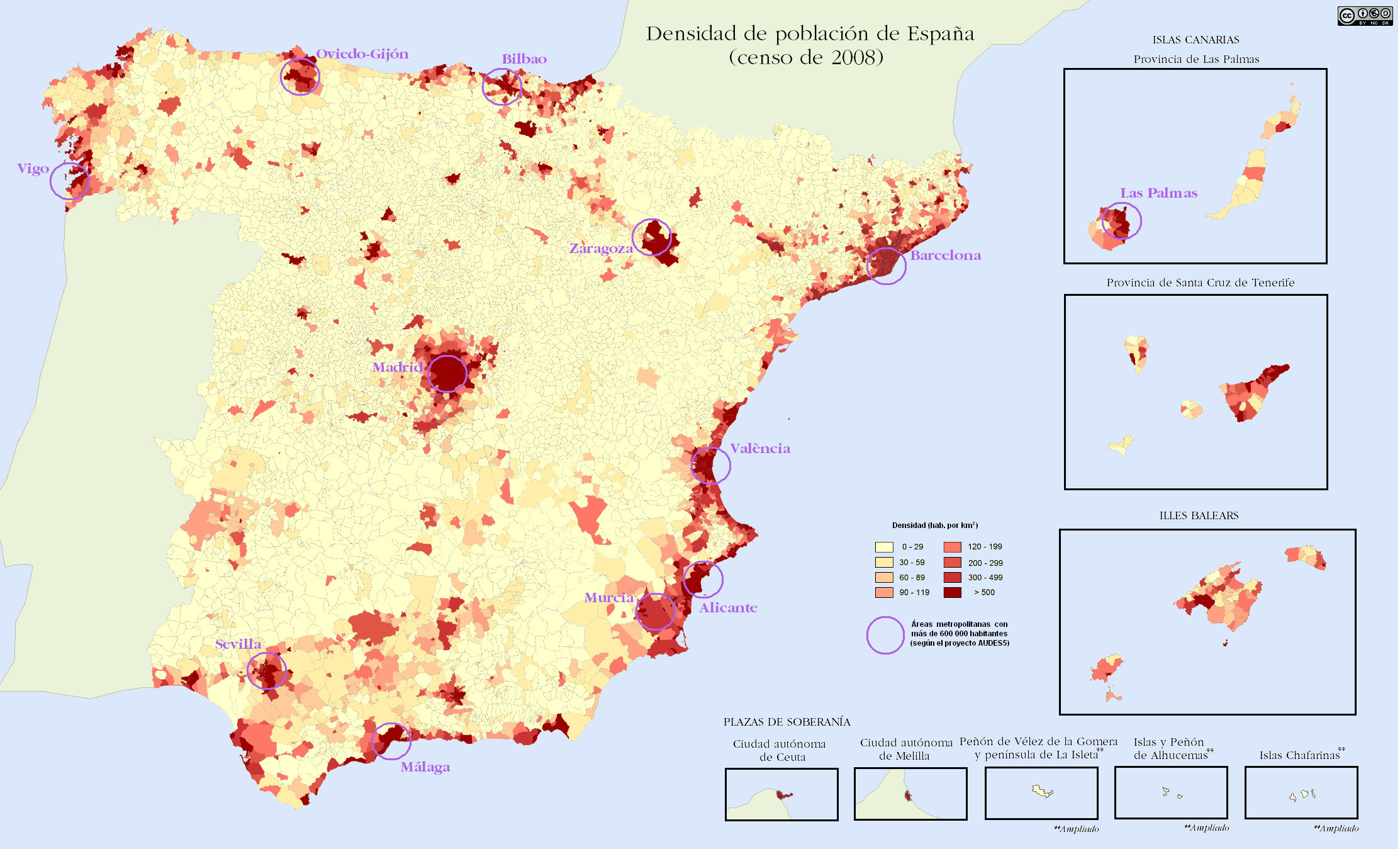 |
| Spain's Population Density. By Susana Freixeiro (Own work) [CC BY-SA 3.0 (http://creativecommons.org/licenses/by-sa/3.0)], via Wikimedia Commons |
Fertility rate:
The fertility rate in Spain is 1.47 children per family. This is also lower than most other European countries.
Spain's population:
Spain's population has increased during the past century. Population growth was especially high from 2000 to 2011. This growth was the result of inmigration to Spain from other countries. In 2012, the population of Spain began to decrease as inmigrants returned home. This was because of high unemployment in Spain.
 |
| Spain's Population from year 1 to year 2015, from wikipedia. |
WHAT POPULATION GROUPS ARE THERE?
We can divide the population of a country into groups according to various factors, such as gender or age.
Gender and age distribution:
Population can be divided into gender groups (males and females). We can also put people into different age groups. This information can be shown in a pie chart.
People that have a common language and culture form an ethnic group. This means that we can divide population into ethnic groups.
We can also divide population into groups according to religion.
Gender and age distribution:
Population can be divided into gender groups (males and females). We can also put people into different age groups. This information can be shown in a pie chart.
People that have a common language and culture form an ethnic group. This means that we can divide population into ethnic groups.
We can also divide population into groups according to religion.
Wednesday, 26 October 2016
DIVIDIR POR DOS Y TRES CIFRAS
Para hacer divisiones de dos o tres cifras:
Tomamos tantas cifras del dividendo como tenga el divisor. Si las cifras del dividendo son más pequeñas que el divisor, hay que añadir otra cifra más en el dividendo.
Para comprobar si nos cabe o no, dividimos el primer número del dividendo (o los dos primeros si hemos añadido otra cifra) entre el primer número del divisor. Si no cabe, probamos con un número menos.
Una vez hecha la resta, bajamos la cifra siguiente y seguimos repitiendo estos pasos hasta que no haya más cifras.
Pinchando en este enlace puedes practicar divisiones con dos cifras en el divisor.
Y en este otro divisiones con tres cifras en el divisor.
Subscribe to:
Comments (Atom)

















